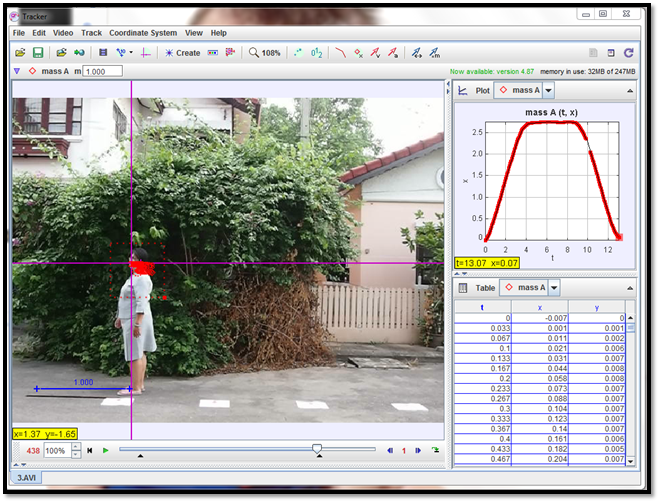การศึกษาผลการจัดการเรียนรู้เชิงปฏิสัมพันธ์ผ่านการวิเคราะห์แทรกเกอร์วิดีโอเพื่อส่งเสริมการเปลี่ยนแปลงมโนมติเกี่ยวกับกราฟการเคลื่อนที่ของนักเรียนชั้นมัธยมศึกษาปีที่ 4
Main Article Content
บทคัดย่อ
การวิจัยครั้งนี้มีวัตถุประสงค์เพื่อศึกษาผลการใช้วิธีสอนเชิงปฏิสัมพันธ์ผ่านการวิเคราะห์แทรกเกอร์วิดีโอที่มีต่อมโนมติเกี่ยวกับกราฟการเคลื่อนที่ของนักเรียนชั้นมัธยมศึกษาปีที่ 4 ของโรงเรียนปรินส์รอยแยลส์วิทยาลัย จังหวัดเชียงใหม่ ภาคเรียนที่ 1 ปีการศึกษา 2560 จำนวน 46 คน เครื่องมือที่ใช้ในการวิจัยประกอบด้วย 1) แผนการจัดการเรียนรู้โดยวิธีสอนเชิงปฏิสัมพันธ์ผ่านการวิเคราะห์วิดีโอแทรกเกอร์ จำนวน 5 แผนการจัดการเรียนรู้ ซึ่งผ่านการประเมินของผู้เชี่ยวชาญ ในการสอนเนื้อหาใช้เวลาสอน 18 คาบ และ 6 สัปดาห์ 2) แบบวัดมโนมติเกี่ยวกับกราฟการเคลื่อนที่ (KR-20 = 0.86) ผลการวิจัยพบว่า Class Average Normalized gain <g> ของนักเรียนมีค่าเท่ากับ 0.52 แสดงว่ามโนมติของนักเรียนเกี่ยวกับกราฟการเคลื่อนที่ดีขึ้นอยู่ในระดับปานกลาง
Article Details
เอกสารอ้างอิง
กระทรวงศึกษาธิการ. (2551). หลักสูตรแกนกลางการศึกษาขั้นพื้นฐาน พุทธศักราช 2551. กรุงเทพฯ: โรงพิมพ์ชุมนุมสหกรณ์การเกษตรแห่งประเทศไทย.
Beichner, R. J. (1994). Testing student interpretation of kinematics graphs. American Association of Physics Teacher, 62, 750.
Bektasli, B. (2006). The relationships between spatial ability, logical thinking, mathematics performance and kinematics graph interpretation skills of 12th grade physics students. Dissertation of the Degree Doctor of Philosophy in The Graduate School of Ohio State University.
Bonwell, C. C., & Eison, J. A. (1991). Active Learning: Creating Excitement in the Classroom. ERIC Digest. ERIC Clearinghouse on Higher Education, Washington DC.1 FGK28050, George Washington Univ., Washington DC.
Calik, M., Ayas, A., & Col, R. K. (2010). Investigating the Effectiveness of Teaching Methods Based on a Four-Step Constructivist Strategy. Journal of Science Education and Technology, 19(1), 32–48.
Gregorcic, B., & Bodin, M. (2017). Algodoo: A Tool for Encouraging Creativity in Physics Teaching and Learning. The Physics Teacher, 55(1), 25-28.
Hake, R. R. (1998). Interactive-engagement versus traditional methods: A six-thousand student survey of mechanics test data for introductory physics courses. American Journal of Physics, 66(1), 64-74.
Hançer A. H., & Durkan, N. (2008). Turkish Pupils Understanding of Physical Concept: Force and Movement. World Applied Sciences Journal, 3(1), 45 – 50.
Hassan, M., & Hamada, M., (2016). Recommending Learning Peers for Collaborative Learning through Social Network Sites. Proceeding presented in 7th International Conference on Intelligent Systems, Modelling and Simulation (ISMS).
Jairuk., A. (2007). The Use of Interactive Lecture Demonstrations in Force and Motion to Teach high school-level Physics. Dissertation of The Degree of Master of Science and Technology Education Faculty of Graduate Studies, Mahidol University.
Miller, L. M., Moreno, J., Willcockson, I., Smith, D., & Mayes, J. (2006). An online, interactive approach to teaching neuroscience to adolescents. CBE Life Science Education, 5(2), 137–143.
Prescott, A., & Mitchelmore, M. (2005). Student misconceptions about projectile motion. In P. Clarkson, A. Downton, A. McDonough, R. Pierce, A. Roche, M. Horne, & D. Gronn (Eds.), MERGA 28 Building Connections: Theory, Research and Practice (pp. 633-640). Melbourne: Mathematics Education Research Group of Australasia.
Rodrigues, M., & Simeão Carvalho, P. (2013). Teaching physics with Angry Birds: exploring the kinematics and dynamics of the game. Physics Education, 48(4), 431–437.
Rudolph A. L., Lamine, B., Joyce, M., Vignolles, H. & Consiglio, D. (2014). Introduction of interactive learning into French university physics classrooms. PHYS. REV. ST PHYS. EDUC. RES., 10, 010103.
SirisathitkulI, C., GlawtanongI, P., EadkongI, T., & Sirisathitkul, Y. (2013). Digital video analysis of falling objects in air and liquid using Tracker, Rev. Bras. Ensino Fís., 35(1), 1504-6.
Sokoloff, D. R., & Thornton, R. K. (1997). Using interactive lecture demonstrations to create an active learning environment. The Physics Teacher, 35(6), 340-347.
Sokoloff, D. R., & Thornton, R. K. (2004). Interactive Lecture Demonstrations: Active Learning in Introductory Physics. Hoboken, NJ: John Wiley and Sons.
Taber, K. S. (2000). Multiple frameworks?: Evidence of manifold conceptions in individual cognitive structure. International Journal of Science Education, 22(4), 399 -417.
Watts, M., & Pope, M. (1998). Thinking about thinking, learning about learning: constructivism in physics education. Physics Education, 24(6), 326-331.


